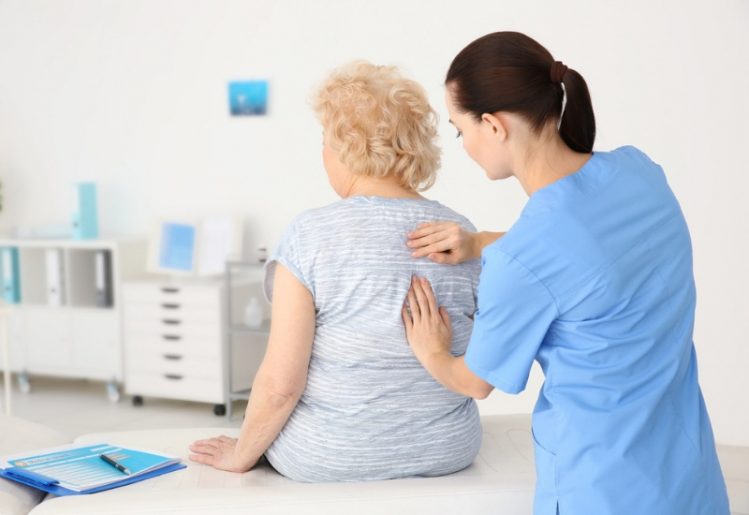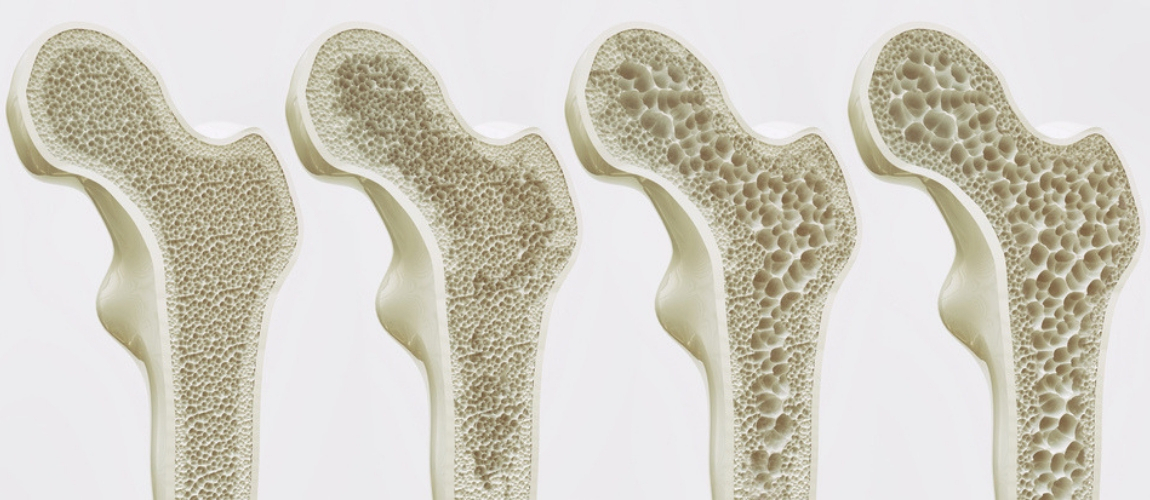While most of us have often heard the term osteoporosis, many people don’t fully understand what this disease entails. Osteoporosis is a degenerative disease in which the production of new bone decreases or stops completely. As we age, our bones naturally lose density, becoming more porous; with osteoporosis, the body’s reduced ability to produce new bone tissue leaves the existing bone weaker and more brittle.
 While men can develop osteoporosis, it more commonly affects post-menopausal women. This is because a woman’s body produces less estrogen as she reaches menopause, and estrogen is the hormone responsible for guarding against the onset of the disease. As the body experiences a diminished level of estrogen in the body, it becomes more susceptible to bone loss. Since people with osteoporosis have weaker bones, they’re also more susceptible to suffering from fractures and other bone injuries.
While men can develop osteoporosis, it more commonly affects post-menopausal women. This is because a woman’s body produces less estrogen as she reaches menopause, and estrogen is the hormone responsible for guarding against the onset of the disease. As the body experiences a diminished level of estrogen in the body, it becomes more susceptible to bone loss. Since people with osteoporosis have weaker bones, they’re also more susceptible to suffering from fractures and other bone injuries.
Osteoporosis is a growing problem that currently affects 53 million people in the United States. One reason instances of the disease are so widespread is that poor lifestyle choices, such as tobacco smoking and unhealthy diets, boost the risks of developing the condition. Since osteoporosis affects the bones, there are few noticeable outward signs of this disease, though one may feel bone pain or begin walking with a stooped posture as osteoporosis develops and worsens.
Currently, there is no cure for osteoporosis. In addition to encouraging patients to engage in more physical exercise and to eat healthier foods, doctors often prescribe drugs to help prevent additional bone loss. However, new research suggests blocking specific brain receptors may more effectively treat osteoporosis by actually increasing bone mass.
Recent Studies May Lead to a New Treatment For Osteoporosis
Researchers recently joined forces from the University of California at Los Angeles and San Francisco to take a deeper look at how estrogen and osteoporosis are related. Led by Dr. Holly Ingraham, the researchers examined how the brain used estrogen to affect metabolism at various stages in an individual’s life cycle. The group concentrated their observations on the hypothalamus, because this is the part of the brain that regulates the relationship between the endocrine system and the nervous system.
Working with animals, the researchers blocked estrogen receptors in the hypothalamus to see what effect a lack of the hormone would have on the metabolism. The result? Researchers noticed that the animals became less active and gained weight. While this may not seem surprising initially, the team was shocked to learn that the weight gain was largely the result of a significant increase in bone mass. Astoundingly, in some animals, bone mass was boosted by as much as 800 percent overall. In addition to building up bone mass, the researchers found that the strength of the bones was also multiplied.
The study examined mice that had already experienced 70 percent bone loss at the start of the study. By denying estrogen to the arcuate nucleus, bone mass was restored by up to 50 percent in those mice. This leads the research team to conclude that, while estrogen in the blood supply does promote the growth of bone, it actually inhibits bone growth once the hormone is exposed to the hypothalamus. The researchers are hopeful that further research will lead to new treatments for osteoporosis, particularly in post-menopausal women.
Maintain Strong Bones with These Lifestyle Changes
Get Enough Protein
Your bones are largely comprised of protein, so a low-protein diet can actually do you more harm than good. It is ideal to take in 0.8 to 1.0 grams of protein per kilogram of weight per day. The best sources of protein are red meat derived from grass-fed cattle, freshly caught fish, eggs, poultry, yogurts, cheeses, nuts and seeds and legumes.
Get More Exercise
 While those suffering from osteoporosis should stay away from exercises that involve jumping and bending, weight-bearing exercise can help to build up bone strength. Activities like walking, swimming, yoga and pilates are ideal for helping to increase bone strength and mass.
While those suffering from osteoporosis should stay away from exercises that involve jumping and bending, weight-bearing exercise can help to build up bone strength. Activities like walking, swimming, yoga and pilates are ideal for helping to increase bone strength and mass.
Prevent Falls and Other Accidents
If you have started to experience bone loss, you’re already susceptible to breaks and fractures, so it’s important to take action to prevent falls. Making use of a walker or cane is a good idea, but also be sure to use railings wherever they’re provided. It may also be a good idea to invest in new shoes that have skid-resistant soles.
Get More Vitamin D
Vitamin D, calcium, magnesium, vitamin K and MSM are just some of the nutrients that can help keep your bones healthy and strong.
In addition to taking a supplement, you should try to spend more time outdoors. Wearing a good quality sunscreen will allow your body to absorb vitamin D without exposing yourself to the harmful effects of the sun’s UV rays. Since vitamin D is vital for strong and dense bones, getting up to 20 minutes of sunshine per day can help you fight off bone degeneration.
Even if new treatments for osteoporosis are still a few years away, there are things you can do to minimize bone degradation now. Essentially, living a more active lifestyle and eating more protein can have a big impact on your bone health. Even as new treatments become available, pursuing healthier choices can only help to boost your bone mass and strength, allowing you to maintain a good quality of life for a longer period of time.

